Drug Rug on the Beach
by Maia Stern
DIY: Mr. Sketch Scented Plaid in 5 Dumb Easy Steps
by Bridget Noone
Transferring to public school was a big deal in third grade. While my Catholic school friends assured me I was going to get my ass kicked, my public school friends said, “Relax. You get to wear nail polish and learn about science now.” I had no idea what to expect.
I got my schedule in homeroom and saw that my first class was Art. After that, I was sold. I really get to show up here wearing jeans and make art every day? Fuck yeah, public school. Hail, Satan!
Our first project, “Making a Plaid,” wasn’t so much art as it was a room full of eight-year-olds sniffing markers, but man, I never felt so alive. Now is your chance to recreate this pivotal milestone of my childhood and feel the limitless possibility of public school arts and crafts in five easy steps.
You will need:
- Paper
- Work surface
- Mr. Sketch scented markers (no substitutions!)
Instructions:
- Smell those markers—smell them all! Then pick four you really like.
- Holding the paper horizontally, draw lines in the same pattern, covering all white space.
- Turn paper vertically and repeat step two.
- Hey, that’s it! You’re done.
- Smell your plaid. That smell is freedom.
title gif by Rosalind Carnes pattern by Alice Alva
Do Not Let Yourself Worry About Interruptions
by Taryn Hubbard
Thinking patterns are felt and shaped and sustained and coifed by more than just the rambling patterns of neurons in the brain.
Sulci—or furrows or fissures or grooves or deep channels—divide the brain into regions called lobes where memories, worries, and insecurities are tucked away, long forgotten. Forgotten until the brain goes back and forth to whatever is hiding in its furrows (a sensation known as anxious furrow-hopping), and triggers a synaptic avalanche of interruption within the day-to-day life of its human.
Born out of a period of particularly painful furrow-hopping, the brain is capable of constructing so-called destructive thinking patterns and negative thinking patterns and distorted thinking patterns as an idle way to re-approach old memories. This could lead to the misremembering of past familiar and friendly faces. After all, most of the faces, ever, are likely sleeping in the squishy furrows of the brain.
However, there may also be opportunity for positive thinking patterns within the furrows. Oh yes! This is what we strive for as humans who can shimmy away from disappointment and grief and regret and guilt without sinking into furrows that hold us back from the daily pattern of life: peaceful sleep, healthy diet, rigorous exercise, productive work, loving sex, and retirement properly squirreled away. Positive thinking patterns are precursors to action and forward motion and the ability to keep furrows clean and fresh and properly archived.
Memories do not have to be distractions.
Pattern
music written and recorded by Tiffanie Lanmon
We Are All Heroes
by Nia King
I run a podcast called We Want the Airwaves, where every week I interview queer and transgender artists of color about how they got to where they are in their careers.
As a filmmaker and cartoonist, I’ve been thinking a lot about story structure, and how the idea of the Hero’s Journey, or the three-act play, often subconsciously structures the way we tell stories, as I found when I was putting this audio clip together.
In the first act of the hero’s journey, we are introduced to our hero and their goal. In the second act, increasingly larger obstacles stand in the hero’s way of getting what they want. In the third act, the hero eventually gets what they want, or they don’t. According to some, all stories, across cultures and across time, essentially follow this same pattern.
This audio clip consists of sound bites from interviews I did with singer-songwriter Kim Tillman, burlesque performer Magnoliah Black, and poet Ryka Aoki. See if you can hear the underlying “hero’s journey” story structure in their tales of self-discovery and self-acceptance through art in the face of racism, poverty, and fatphobia.
images and gif
by Yesica Balderrama
The Case of the U.S. Space Camp Mission
by Maija Ekey


































collaged Vine devoted to Solange (left)
by Emily Stephenson
Odes to Solange
by Kerensa Cadenas
Somethings Never Seem to Fucking Werk
What does always werk
Solange in polka dots
Florals
Checks
Geometrics
Modern ladies want modern lewks
Lewkin' fresh to death
In those bright florals
Warm hexagons
Chill stripes
Natural hair
Tangerine lips
Flight Pattern
by Rebecca French
Left, Right, Left
drawings and text by Julia Landau
As a nation, we walk on average at 3 mph. I am one of the millions of New Yorkers that walk at 4.4 mph. But walking fast is not to be confused with walking well, and it has its consequences. New Yorkers walk ourselves into 38 million pedestrian crashes per year on the streets of the five boroughs. Though is that really very surprising?
Reckless walking is everywhere in the city: learn to recognize its patterns and perpetrators (listed below), and stay safe out there.
Miss Indignant: Probably the most common character in New York, the indignant throws her hands up in the air as a cab runs a red light. Her face says, What the fuck? when a car makes a turn without yielding to pedestrians. She can be spotted screaming at a bus that's blocked the crosswalk. "How can I be the only sane person in New York?" the indignant asks herself. But she’s not sane, and she’s not the only one.
The Wanderer: Stopping dead on a crowded street is a clear tourist indicator, though often it’s just a native trying to play like she’s indecisive. Either way, the effect is the same: those behind the Wanderer cannot suddenly adjust to the stop, and pretty soon there’s a pile-up of rolling suitcases, little dogs, and heels.
Glued to the Smart Phone: Please pull your head out of Ok Cupid, Instagram or your emoji cache long enough to see that I'm right in front of you and trying to walk into Uniqlo.
The Barricade: A too-common group endeavor that blocks the sidewalk by walking four- or five-abreast—sometimes with arms linked—rendering passing nearly impossible, this blockade is also one of the slowest walking phenomena.
Captain Crosswalk: Motivated by rank, he keeps inching one step ahead as you, and the crowd on the curb, wait for the crossing signal to change. Though it seems he couldn’t take another step without walking head-on into traffic, he inches up even further, defying you in his determination to lead the pack across the street.
Renegades: Just as salmon swim against the rapids, these trailblazers defy foot traffic at rush hour. (Why walk down the wrong side of the subway staircase at Grand Central?). Salmon are valiantly return to their breeding grounds, whereas the Renegade’s motives remain unclear.
Tina, the Tight Turner: By the time she’s quickly, unwisely rounded that blind turn, she’s knocked over someone’s coffee, thereby destroying a leather-bound portfolio and her new suede oxfords.
The Drifter: This most egregious, blissfully ignorant pedestrian slowly floats from one place on the sidewalk to another, thwarting any attempt to pass him. It's uncanny, really: it seems he knows exactly where you'll move to pass him, and there he drifts, blocking the way.
stoop-drinking china pattern
by Mary Finer
Polka
by Nona Willis Aronowitz
I bought this incredibly versatile black-and-white polka dot dress with a thick black waistband at H&M in 2006. I wore it on the first day of my first full-time job. I wore it the night I met and promptly hit on my future manpiece. I was wearing it on the day I got fired from a waitressing job. Now that it’s starting to thin and fray, I wear it on 90 percent of airplanes I fly in. On a couple of drunken occasions, I’ve worn it to bed.
To me, polka dots are Proustian. My personal touchstones of the pattern reside not in Betty Boop or Itsy Bitsy but in movies of the late eighties and early nineties, beginning with a home video starring me in 1987: when the person behind the camera asked me what my favorite color was, I proclaimed, “Dots!” Ever since, a series of polka-clad female characters have convinced me that polka is a Power Pattern, which doesn’t mean its associations aren’t complicated. The polka dot is a well-rounded woman—a few women in particular: Sue Ellen Crandell, Vivian Ward, Rachel and Charlotte Flax, and Those Extras in Dirty Dancing. Let’s look at them in order of increasing importance.
by Carly Correa
We are all beautiful, gleaming, shimmering, tiny, iridescent pieces of confetti floating, flying, falling, swirling. Everything tends towards randomness and disorder, yet we try to make sense of life's surprises by creating organizational structures and patterns. Break out of your routines, then return to them safely at the end of each night.








AMERICAN DREAMIN'
by Maija Ekey
Bonus: Mad Men
Years later, I remembered Winona Ryder’s Charlotte when Betty Draper’s night as the perfect, coiffed hostess is ruined when Don humiliates her with his Heineken experiment (and his extramarital affairs). By the next morning, her happy-housewife costume has morphed into a rumpled sad-clown suit: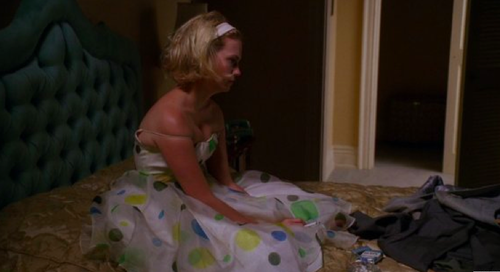
Suddenly dots are not fun. Not fun at all.
Yet every one of these cases end in redemption. The dirty dancers storm the dance floor, because nobody tells them they can’t party. Sue Ellen comes clean to her coworkers about her age and kisses a man in a polka dot bowtie. Vivian faces who she is and rescues her prince right back. Charlotte and Rachel finally communicate amid the jumble of tragedy. Betty gets the fuck out of her toxic marriage. Polka dots expose so much innocence and naiveté and sensuality and risk-taking and layers of truth that eventually, beautifully, you end up naked.



Mermaids
In Mermaids, the polka dot is practically the main spot-blowing character. Rachel Flax is a gorgeous, sexy, modern woman with two matching polka dot dresses: one pink, one blue, all wiggle. She wears dots when she smokes a cig on the street: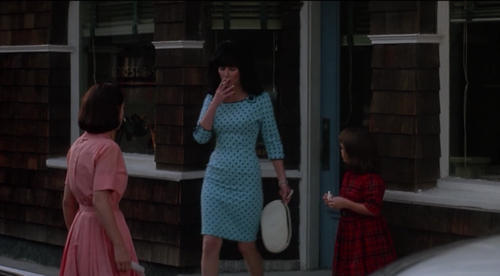
When she demurely enters a room:
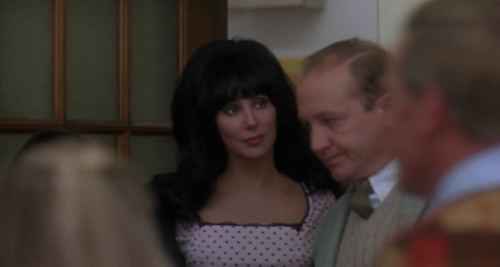
And when she brashly flirts with her next conquest: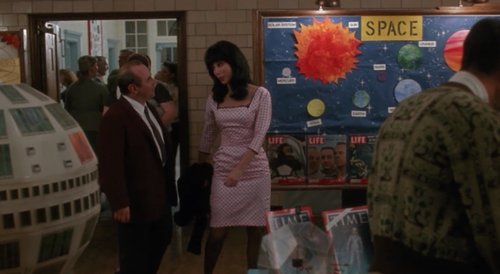
Later, the polka dot dresses show up again—this time when her daughter Charlotte’s feeling naughty: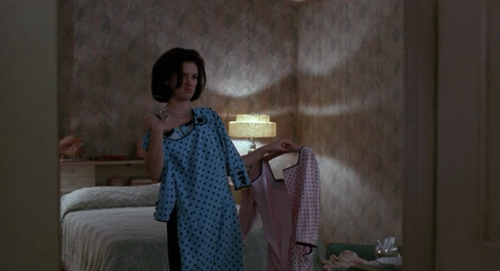
next >>>
And grown-up: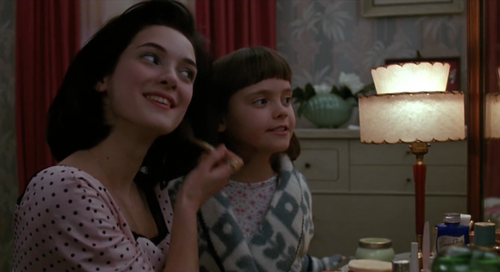
And reckless: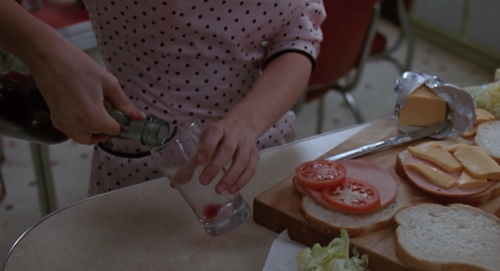
So reckless that she decides to lose her virginity in the bell tower while her drunk, 8-year-old sister almost drowns: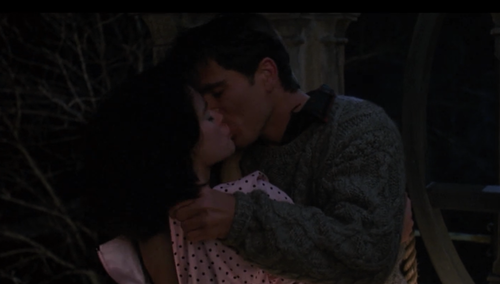
Polka dots veer from lusty and exhilarating to dizzying and dangerous in a matter of minutes. As the dress becomes looser, the lipstick smears, and the polka dots seem mocking. Tragic. Spot(s) blown.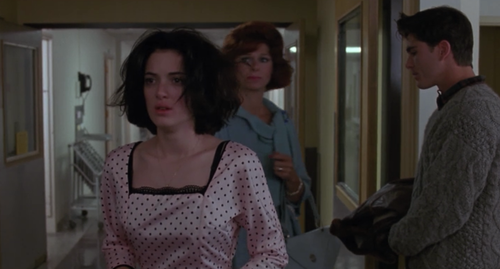
next >>>
Dirty Dancing
You remember that couple in Dirty Dancing’s “Do You Love Me?” scene? The couple that first causes Baby’s jaw to drop, who were clearly the best dancers in the room before Johnny and Penny show up? The couple wearing matching polka dot outfits?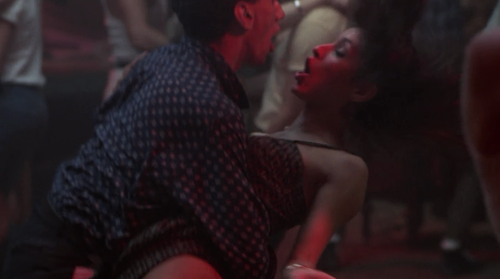
Okay, so her sorta-polka hinges on his unequivocal polka. But at the triumphant last dance, she wore it properly: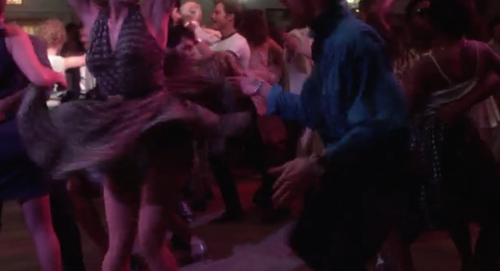
So did she: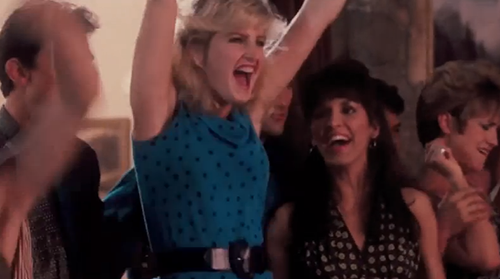
And so did she: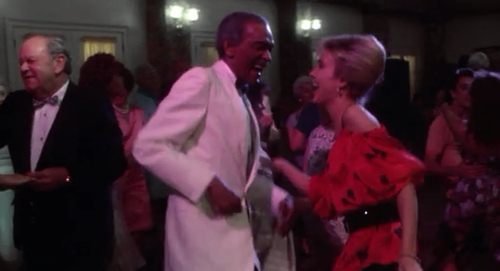
next >>>






Don't Tell Mom the Babysitter's Dead
Still, polka is not a symbol of unilateral joy. Polka dots also expose absurdity and painful truths. They can rip open wounds at the most inopportune times. Sure, Sue Ellen Crandell was wearing polka dots during her career-woman transformation in Don’t Tell Mom the Babysitter’s Dead: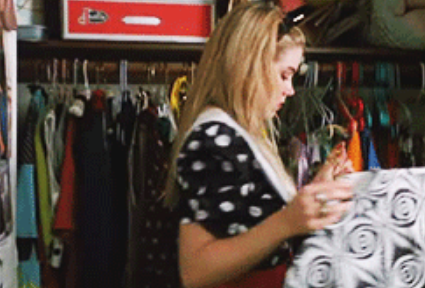
but wearing them was also a source of humiliation at Clown Dog (and her mortification at the movie’s end, when her estranged boyfriend Brian unwittingly blows up her spot):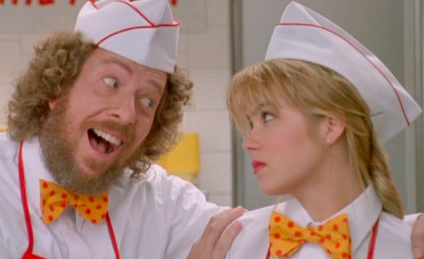
Pretty Woman
The polka dot can be a false sense of armor, only to explode in a
million tiny pieces. Take Vivian in Pretty Woman. She’s having the time of her life at the polo game, embracing a rare chance to be “Cinda-fuckin-rella”: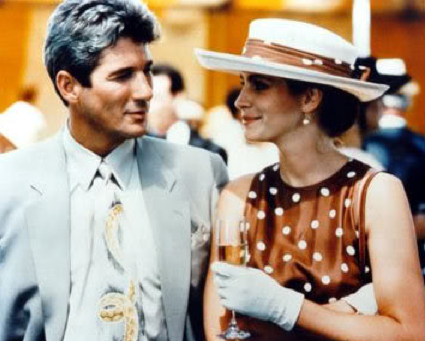
Yet that same moment—where she charms the pants off one stiff WASP after another—precedes the ickiest exchange in the movie, perhaps of all time, where Stuckey reminds her that no matter how many adorable polka dot dresses she wears, the world sees her as a whore. Spot(s) blown.
next >>>
Patterns of Eating: How I am Learning Not to Binge
by Erin McKelle
It’s 4pm and I’ve just gotten home from school. I look through the cupboards and at all of the chips, cookies, and cakes to be had, counting down the hours until I can be with them.
Now it’s 6pm and I’ve just had dinner, but my appetite is not nearly fed.
9:30pm and I am negotiating with myself over how many cookies I’ll eat, since I’ll want some for tomorrow, and, if anyone opens the package, I don’t want them to see how many are gone.
10:45pm and everyone is finally asleep. I tip-toe down the stairs to the kitchen and prepare a Mecca of junk food: sandwiches, chips, gummy bears, and some Girl Scout Cookies I found yesterday in the back of the pantry. I watch myself slipping and feel disguised, but I don’t care. My stomach feels heavy and cumbersome, but I continue to eat until all the food I prepared is gone.
I’ve had a turbulent relationship with food for a while, and, at age 18, I am beginning to recognize this. I have internalized a good deal of fat shame from my childhood: naturally heavier and shorter, I was treated differently in subtle ways. My stepmom bought me one-piece swimsuits to take on vacations; my stepsister got tiny bikinis. I was never liked by boys at school, and if I wanted to wear a mini-skirt, my mom would practically have a stroke: while she never made direct comments about my weight, I somehow felt that if I were thin, my clothing choices wouldn’t have been an issue.
This subtle messaging affected my relationship with food. When I reached adolescence, I began to feel the comfort that a brownie could give me after a long day at school, or the pleasure that a bag of Flamin’ Hot Cheetos could instill after dance practice. Suddenly, I wasn’t just eating when I was hungry; I was eating because it soothed me. I knew my behavior was problematic, but I didn’t know how to stop. Eating was a compulsion, and binging became a habit. I knew what I needed to do to be healthy, but I felt that my cravings for food were stronger than my desire for wellness.
Recently, I realized that I didn’t want to have to face the health consequences of my eating habits and saw that I’d have to start making some changes if I wanted to have a good quality of life.
I am finally getting my binging under control. It’s no longer a nightly occurrence and, while I still do it occasionally, the urge is subsiding. Food isn’t running my life anymore—I can enjoy it more easily now without shame and am healing from all the damage I’ve done. I’ve learned that patterns can be broken, and mine do not define who I am.
The Strawberry Thief pattern (made in 1883 and shown here in e-kaleidoscope form) is my favorite. Thrushes feasting in the strawberry bushes outside his estate—Kelmscott Manor, in Oxfordshire—inspired Morris to create the fabric, which quickly became a best seller among his clients. On it, a pair of open-mouthed birds face each other, a salmon-colored lotus-like blossom between them. They sit atop stems that sprout filigrees and curve into pink and blue blossoms, connecting with the greenery above another pair of sharp-eyed thrushes. These birds crouch, ready to take flight and escape; they’ve already got bright-red berries in their beaks. The brightest spots in the pattern are more of those red berries, hanging in clusters, not to diminish the bursting blues of the blossoms that frame the scene, originally colored by indigo. The colors are so riotous you can practically hear the birds jeering at one another.
I imagine that having Strawberry Thief on my walls, or as my curtains, would basically feel the same as having my own country house, and I could look outside to see and hear the thrushes making war in my strawberry bushes. Either the curtains or the country house, my nerdish brownstone Brooklyn dreams wander there. But dragging my mouse across the screen and watching the birds collapse into fields of blue paisley will be enough for now.
BH: Have you seen any patterns among the organizations and institutions that you examine for this project?
LD: Sometimes there are organizations with women, but they’re almost always in HR roles or administrative roles. Or you’ll have an institution where the board’s all men but the executive director is a woman, the person who actually runs shit but doesn’t have any decision-making power or prestige. All the listed contributors [to the Freakonomics blog] are male, but the editor is female. The editors hired by [Steven D.] Levitt and [Stephen J.] Dubner, they probably do have some discretion as to who writes for them. So women aren’t always good for women within an institution.
BH: Have you gotten reactions from anyone featured on 100 Percent Men?
LD: I’m always sort of flabbergasted by the unconsciousness of these bodies to their 100 percent maleness. One person inside one of these companies got wind of it and tweeted about it, and he was clearly ashamed. He was like, “We’re working on it, it’s bad.” And I’m really curious to know if [the blog] made its way to anybody else featured, because it should be shameful. It’s definitely shaming.
BH: Was that part of the impetus to create the site, that element of public shaming?
LD: I had no sort of long-term consciousness, I never expected [100percentmen] to spread. But now that it has, I’m glad it serves that function. And I think it also serves the function of just making people think about it. That sounds really banal and obvious, but I have male friends of mine who just keep sending me stuff being like, “Holy shit, I can’t stop seeing it now.” Maybe once you realize that, it triggers something in their brain that’s like, “Oh dear, this is everywhere.”
My English Garden Fantasy
by Elyse Moody
Chrysanthemums, willow boughs, acanthus leaves, larkspur, apples, honeysuckle, thrushes: William Morris’s nineteenth-century fabrics and wallpapers practically explode in kaleidoscopic patterns. Birds and blossoms pop against fields of unfurling leaves and undulating vines; they shoot forward while smaller flowers and fruits recede into the background. The practical need to trim a fabric or wallpaper to size, in squares, imposes order on the chaos, the way rosebushes do in an English garden, and the effect is psychedelic—in a British country house kind of way. A William Morris print is precisely what I imagine Alice, post-Wonderland, might have chosen for her home.
I wanted to see what would happen if I put Morris’s prints into a kaleidoscope, and I found a satisfyingly lo-fi version online. The program instructed me to upload an image, then drag my cursor across the image to collapse it into triangulated versions of itself: versions that dissolve and dissolve, again and again. It’s pretty mesmerizing.
But Morris probably wouldn’t like my homage to his work. He’d be liable to say I digitally bastardized his painstakingly handcrafted designs in at least three ways: (1) by viewing them on a computer screen; (2) through a somewhat janky but totally engrossing kaleidoscope program on a ’90s-era website; (3) and by filming that reproduction with my equally janky iPhone 4, using an app called Vine. These cascading e-manipulations set me in diametric opposition to Morris, who, ever the purist, thought that art should be direct, unadulterated, and rooted in nature.
The guru of the Arts and Crafts movement, he famously instructed fans of his interior decoration to “have nothing in your house that you do not know to be useful, or believe to be beautiful.” He pushed back against the spit-shine attitude of the Industrial Revolution by advocating for minimalism in historical preservation (i.e., let the walls crumble if they want to), and by re-popularizing medieval methods of illustration, calligraphy, and printing.
William Morris wallpaper designs are—to me—the ultimate in timeless, nature-inspired interior decoration, just like the mounted butterflies that hang framed on my wall. I first saw his prints in the Ashmolean Museum gift shop in Oxford, while studying abroad in England. I bought myself a coaster there that I have superglued back together at least 30 times (after my cat knocks it off my bedside table). I have an inordinate love for it; not including stationery, it is probably the only William Morris item I will ever be able to afford for my house. I adore it.
Boyz II Many
an interview and collage by Brooke Hatfield
Lydia DePillis covers business policy for the Washington Post’s Wonkblog. She also created the Tumblr 100 Percent Men, which documents “corners of the world where women have yet to tread” via screenshots and descriptions of all-male groups like the leadership at Apple, the writers in New York’s politics section, and the papacy.
I spoke with DePillis about the procrastiworking that led to the site’s creation, patterns in high-ranking female hires, and the efficacy of public shaming. This interview has been condensed and edited.
Brooke Hatfield: So how did 100 Percent Men come about?
Lydia DePillis: It was a Sunday, and I was procrastinating. I found that I was irritably tweeting a lot of groupings of men that I would come across on my beat, which is very heavily male. [At the time of this interview, DePillis was covering tech for The New Republic.] I’d never made a Tumblr before, and Tumblr seemed like a place where you warehouse this kind of stuff. So I put up some [examples] that I’d noticed.
BH: Have any of the reactions to the site surprised you?
LD: I’m definitely surprised by how much it resonates with people. I did get one or two tweets saying, “Just lay off the men thing! You’re not even offering a solution!” And there’s been a couple blog posts to that effect, too, like “What do you want from us? Are you saying things should change and we should just hire token women?” Of course it’s a legitimate response, because no, hiring token women would be more damaging in a way. Not all journalistic projects need to offer a solution. That’s not my job, it’s not up to me.
BH: So is it possible to disrupt these boys’ clubs?
LD: It’s a really complicated problem and a lot of academics have been working on it for years. I’ve written about this in tech. The only way to solve this in a really systemic way is to have all girls, everybody, required to take computer science, because otherwise they’re just going to be damned by selection bias forever.
Pattern
sheet music that corresponds with autoplayed audio
by Tiffanie Lanmon


























